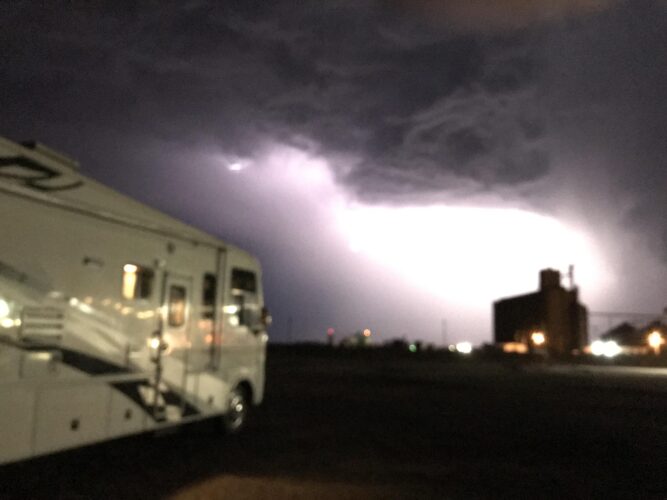Beautiful spring afternoons, tornadoes, and lightning storms are a fact of life in many parts of the country. When you see one, you can’t help but wonder “What happens when lightning strikes an RV? Can it actually hit us?” The truth is that a direct strike is rare, but can certainly happen. The good news is that if it does, being inside your RV is pretty safe. This is thanks to a concept called the “Faraday Cage Effect.” Let’s look at how it can prevent you from getting killed (although we can’t say the same about your electronic devices). Here’s why.
Lightning Strikes to RVs and Cars Happen, But You’ll Probably Live Through It
Every year the U.S. sees about 20 lightning fatalities, and hundreds more get permanently injured, according to the National Oceanic and Atmospheric Administration (NBOAA). The reality is that if you’re in an RV when weather radar shows a pending lightning storm, your chances of being affected by lightning do rise. A direct strike is unlikely, but your RV can be affected in other ways.
Here’s what can happen if your metal, fiberglass, or wood frame RV is hit by lightning in a campground or while moving.
In a direct strike, lightning moves through RV tires
If you drive down the road and see a lightning flash, don’t assume that rubber tires keep your RV from getting hit. That’s a myth. Lightning can strike an RV and other vehicles just as easily as it hits lightning victims standing next to trees, golf clubs, or riding in fishing boats. But thanks to a phenomena called “The Faraday Cage Effect,” if your rig has a metal roof and sidewalls, the lightning will travel around the side of the camper, not inside. Here’s why:
“A typical cloud-to-ground, actually cloud-to-vehicle, lightning strike will either strike the antenna of the vehicle or along the roofline. The lightning will then pass through the vehicle’s outer metal shell, then through the tires to the ground,” explains the U.S. National Oceanic and Atmospheric Administration (NOAA). In their article “Lightning and Cars,” NOAA experts also say that “it’s very common for the lightning to destroy one or more tires as it passes through the steel belts to the ground.”
National Oceanic and Atmospheric Administration (NBOAA), “Lightning and Cars.”
In a direct strike electricity probably won’t penetrate inside your big metal box.
The inability for electric current to go inside your steel or aluminum cage during a direct strike is known as the Faraday Cage Effect. It’s named after the 19th century scientist Michael Faraday. He taught us that a metal or aluminum “cage” acts as a conductor to move electrical flow. In an RV’s case, lightning moves along the outside of the rig, into the tires, then back into the earth.
If lightning strikes an RV and you are inside the rig, do not touch anything connected to the metal structure. “As long as the passenger does not make contact with the outer metal shell i.e. by touching internal parts such as the steering wheel, radio knob or door handle, he/she will be safe,” explains Environment Canada, in their article “Lightning Safety When Camping.“
But other parts of the RV will probably be affected
Some strikes are more powerful than others, causing varying degrees of damage. For example, your camper antenna will melt because this is the initial point where the lightning makes contact.
Additionally, your electrical systems may burn out due to the huge surge electric source that hit it. Scorch marks may appear on the exterior. You should also expect at least one tire to melt or blow out during this event. In rare circumstances, a direct lightning strike can cause a gas tank explosion or cause the vehicle to catch fire.
Your RV is More at Risk By Indirect Lightning Strikes
Fortunately, most lighting strikes hit taller objects, like trees. When this happens, your RV can still be impacted by an indirect strike. As lightning moves, it sends high voltage spikes through electrical wires, then into your RV pedestal plugs, and finally into your RV’s electrical system. More RVers are impacted this way than by direct lightning strikes. Thankfully, a good RV insurance provider will usually cover the cost of lightning damage.
@thecityman, iRV2 Forums member, “RV Lightning Strike, what now?“So, last week a huge bolt of lighting hit a utility pole about 100 feet from my camper. It completely destroyed the pole (literally cut it in half). Well, apparently it followed the electric or cable wire into my camper. And yes, I had one of those surge protectors plugged into my electric source at the plug, and my camper was plugged into it. Apparently it didn’t help.
What If an RV is Made of Fiberglass and Gets Hit by Lightning?
If a direct lightning strike happens to an RV with a metal shell, it will probably survive. But RVs made of fiberglass or plastic are another matter. The Faraday Cage effect doesn’t apply to fiberglass RVs in lightning storms. It can travel right through a non-metal camper, striking anything in its path.
What to Do If You are RVing in a Lightning Storm
If you hear thunder, lightning is not far away. Sometimes bad weather unexpectedly hits an area, so it’s not always possible to relocate your RV ahead of time. If you are caught in a dangerous place with lightning, sometimes the best you can do is follow these basic safety tips:
Follow weather warnings (and act on them)
Your first line of defense against a lightning strike is weather alerts. A thunderstorm watch might come from the TV, or radio, but you’ll probably get warned first through your cell phone. Be sure your cell is set to receive emergency alerts wherever you are located.
- Thunderstorm watches mean that the conditions for a lightning strike are present, but there isn’t a clear and present danger.
- Thunderstorm warnings mean that you should take action/seek safe shelter immediately. If you act quickly, you can usually avoid or minimize the danger.
Retreat to a building or your tow vehicle, if possible
Although most RVs can withstand a lighting strike, it’s not the safest option. If you can reach a safe shelter, this will usually give you better protection and distance from the effects of a lightning power surge. But if you are on the road, in a parking lot, or in a campsite where there isn’t a building within reach, stay in your vehicle. Don’t venture outside.

Avoid large trees
Trees might absorb the main impact of a lightning strike, but they can burst into flames, split, or fall over onto your camper. If you have enough time to act on a thunderstorm warning, try to head for an open area that is low in elevation.
Unhook the RV from the power outlet
RVs can be hard to move when you only have a few minutes notice. In this case, you should buckle in and prepare for the possibility of a lightning strike. If your RV is connected to hookups in your campsite, take a minute to disconnect it. The electrical surge that comes from lighting could be amplified by an electrical hookup and fry your entire system.
Get away from windows, doors, and anything made of metal
During the lightning storm, cover yourself with a protective blanket and stay away from windows, and doors. Try to remain in the center of the RV. If you are hit by a strike, don’t touch anything metal after it happens. Residual electricity might still be on these parts, so it’s best to leave them alone. Use rubber gloves if you need to touch metal or open a door.
Keep a first aid emergency kit handy
Your RV always needs a first aid kit and 72-hours of food, water, and clothing. You will probably never be too far away from help, but it’s useful to prepare yourself for the possibility of having now way to get help for a while.
Follow the lightning safety tips, and you’ll have a good chance of staying safe if a thunderstorm starts brewing.




